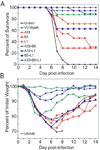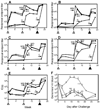Smallpox vaccines: targets of protective immunity
- PMID: 21198662
- PMCID: PMC3074351
- DOI: 10.1111/j.1600-065X.2010.00975.x
Smallpox vaccines: targets of protective immunity
Abstract
The eradication of smallpox, one of the great triumphs of medicine, was accomplished through the prophylactic administration of live vaccinia virus, a comparatively benign relative of variola virus, the causative agent of smallpox. Nevertheless, recent fears that variola virus may be used as a biological weapon together with the present susceptibility of unimmunized populations have spurred the development of new-generation vaccines that are safer than the original and can be produced by modern methods. Predicting the efficacy of such vaccines in the absence of human smallpox, however, depends on understanding the correlates of protection. This review outlines the biology of poxviruses with particular relevance to vaccine development, describes protein targets of humoral and cellular immunity, compares animal models of orthopoxvirus disease with human smallpox, and considers the status of second- and third-generation smallpox vaccines.
Published 2010. This article is a US Government work and is in the public domain in the USA.
Figures




References
-
- Fenner F. The eradication of smallpox. Prog Med Virol. 1977;23:1–21. - PubMed
-
- Hanna W, Baxby D. Studies in smallpox and vaccination. Rev Med Virol. 2002;12:201–209. 1913. - PubMed
-
- Fenner F, Henderson DA, Arita I, Jezek Z, Ladnyi ID. Smallpox and its eradication. first ed. Geneva: World Health Organization; 1988.
-
- Talbot TR, et al. Vaccination success rate and reaction profile with diluted and undiluted smallpox vaccine: a randomized controlled trial. JAMA. 2004;292:1205–1212. - PubMed
-
- Rock MT, Yoder SM, Talbot TR, Edwards KM, Crowe JE. Adverse events after smallpox immunizations are associated with alterations in systemic cytokine levels. J Inf Dis. 2004;189:1401–1410. - PubMed
Publication types
MeSH terms
Substances
Grants and funding
LinkOut - more resources
Full Text Sources
Other Literature Sources
Medical

